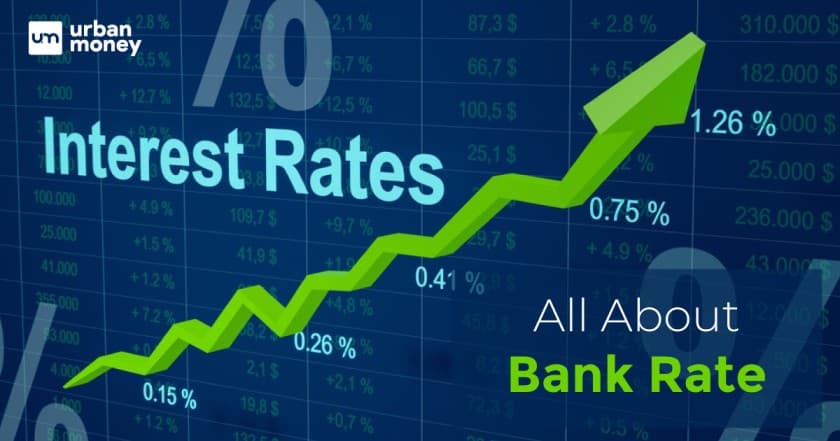What is a Bank Rate

- Personalized solutions
- Expert guidance
- Application assistance
- Credit score discussion
- Interest rate comparison


Last Updated: 27 December 2025
The bank rate is the interest rate the Central Bank charges on funds lent to commercial banks. When a bank’s funds are depleted, it can borrow money from the RBI to continue operations.
It has an impact on commercial bank lending rates. Higher bank rates will imply higher lending rates by banks. To reduce liquidity, the central bank may raise interest rates and vice versa. Increases in bank rates directly impact the lending rates offered to customers, limiting people’s ability to obtain loans and harming overall economic growth.
This guide explains what is bank rate and talks in detail about the essential aspects of the bank rate in India.
How Does Bank Rate Work?
Banks use commercial and treasury bills for these and cash them at discounted rates. Second, bank interest rates can be charged as a penalty rate. This is significant because when banks fail to meet their SLR or CRR, the central bank imposes penalties based on the prevailing bank rate.
The repo rate is the interest rate at which a country’s central bank (in India, the Reserve Bank of India) lends money to commercial banks in the event of a funding shortage. Monetary authorities use the repo rate to control inflation.
Types of Bank Rates In India
The Monetary Policy Committee (MPC) requires a mixture of different bank rate policies to keep the Indian economy from slipping into the den of inflation. There are different types of bank rates in India contributing to the MPC’s attempts. They are explained below.
Repo Rate and Reverse Repo Rate
Bank rate and repo rate are similar terms and often confuse one another. The repo rate, an abbreviation of Repurchase Agreement or Repurchasing Option, is the rate at which the RBI provides commercial banks with loans against government securities. In this case, the banks will purchase the securities from the RBI. The RBI attempts to propel the cash liquidity or drain the excess by changing the repo rate. The current repo rate (dated January 7, 2023) is 6.25%.
The reverse repo rate can be the reverse of the repo rate. It is the rate at which commercial banks lend funds to the RBI. This instrument helps control inflation as the excess of funds with commercial banks is borrowed by the RBI and returned with the charge as and when the banks require. The current reverse repo rate (dated January 7, 2023) is 3.35%.
Statutory Liquidity Ratio (SLR)
A commercial bank must retain a percentage of liquid cash, gold or other securities as deposits. This is known as Statutory Liquid Ratio or SLR and is controlled by the RB. In essence, it is the minimum amount of reserves that banks must have to extend credit to clients and are held by the banks themselves, not the RBI.
The convenient tool, SLR, is used by the Monetary Policy Committee (MPC) to regulate inflation, credit expansion, and liquidity flow and was established as per Section 24 (2A) of the Banking Regulation Act of 1949. The SLR on January 7, 2023, is 18.00%.
Cash Reserve Ratio (CRR)
Cash Reserve Ratio (CRR) is a percentage of deposits required by commercial banks to be maintained in the form of liquid cash with the RBI as reserves. Unlike SLR, banks do not keep a balance with themselves. The CRR contributes to determining the base rate and is a part of the RBI’s monetary policy. It is also a measure by the RBI to control the cash flow in the Indian economy. The CRR as on January 7, 2023, is 4.50%.
Marginal Standing Facility Rate (MSF)
Marginal Standing Facility (MSF) is a facility extended to commercial banks by the RBI in the event of an emergency to obtain liquidity overnight. The option is available to the banks of the inter-bank liquidity is dried up. Under the Liquidity Adjustment Facility or LAF, banks borrow from the RBI by pledging government securities at a rate higher than the repo rate. The MSF rate is set at 100 basis points, or one percentage point, above the repo rate. Under MSF, banks can borrow up to 1% of their Net Demand and Time Liabilities (NDTL). The MSF rate as on January 7, 2023, is 6.50%.
Lorenz Curve
A Lorenz curve is a graphical representation of income or wealth inequality developed by American economist Max Lorenz in 1905. The graph depicts population percentiles based on income or wealth on the horizontal axis and cumulative income or wealth on the vertical axis.
Non-Performing Assets (NPAs)
A non-performing asset (NPA) is a loan or advance on which the principal or interest payment has been late for 90 days. Banks are required to categorise NPAs further as the following.
- Substandard Assets: Assets that have been NPA for less than or equal to 12 months.
- Doubtful Assets: An asset is questionable if it has been in the substandard category for 12 months.
- Loss Assets: According to the RBI, a loss asset is considered uncollectible and of such low value that its continued existence as a bankable asset is not warranted, even if there may be some salvage or recovery value.
How is a Bank Rate determined?
The Monetary Policy Committee (MPC) of the RBI sets the bank rate to control the economy’s money supply and the banking sector. This is usually done quarterly to keep inflation under control and the country’s exchange rates stable. Section 49 of the RBI Act of 1934 mandates the publication of the Bank Rate. This rate has been aligned with the MSF rate and changes automatically as the MSF rate changes in tandem with the policy repo rate.
Any change in bank rate causes a domino effect that affects every aspect of a country’s economy. For instance, stock market prices fluctuate due to changes in interest rates. Changes in bank rates impact customers because they affect the rates at which they can obtain loans.
What is the Bank Rate in India?
Each domestic or commercial bank is charged 6.50% as the current bank rate in India as on January 7, 2023. As established, the bank rate keeps changing as the RBI attempts to shield the Indian economy from circumstances like inflation. It directly impacts the customers as it directly affects long-term lending by catering to a bank’s long-term requirements.
Conclusion
The bank rate can be compared to a quarterback charging at inflation. Banks seek loans from the RBI to maintain liquidity and meet reserve requirements. In response to the global crisis, many central banks altered their interest rates to stimulate and stabilise the economy. We hope you understand the economic term- bank rate.
Frequently Asked Questions (FAQs)
What is the difference between Bank Rate and Repo Rate?
The terms- bank rate and repo rate are often used interchangeably. However, there remain a few critical differences between the two. The significant difference is that the bank rate is the rate at which the RBI lends money to commercial banks and requires no collateral. In contrast, the repo rate is the rate at which the RBI repurchases government securities from commercial banks and collateral is required.
Who decides the Bank Rate?
The Monetary Policy Committee (MPC) decides the bank rate in India. The committee gathers at least four times a year and is responsible for fixing a benchmark for interest rates.
What is the bank rate according to RBI?
According to the RBI, the current bank rate for 2023 is 6.50%.
What are CRR and bank rates?
The RBI has made it mandatory for commercial banks to maintain a ratio of their total deposits as liquid cash for emergencies. This is known as the Cash Reserve Ratio (CRR). On the other hand, bank rate refers to the rate at which the RBI lends loans to commercial banks.
What are bank rate and base rate?
The bank rate refers to the rate at which the Reserve Bank of India (RBI) furnishes loans to commercial banks in India, whereas the base rate is the rate at which commercial banks provide loans to borrowers in India.
Bank rate, what is bank rate, bank rate meaning, current bank rate, bank rate vs repo rate, bank rate and repo rate, bank rate means, bank rate in India, bank rate rbi, bank rate today, bank rate policy, bank rate 2023
